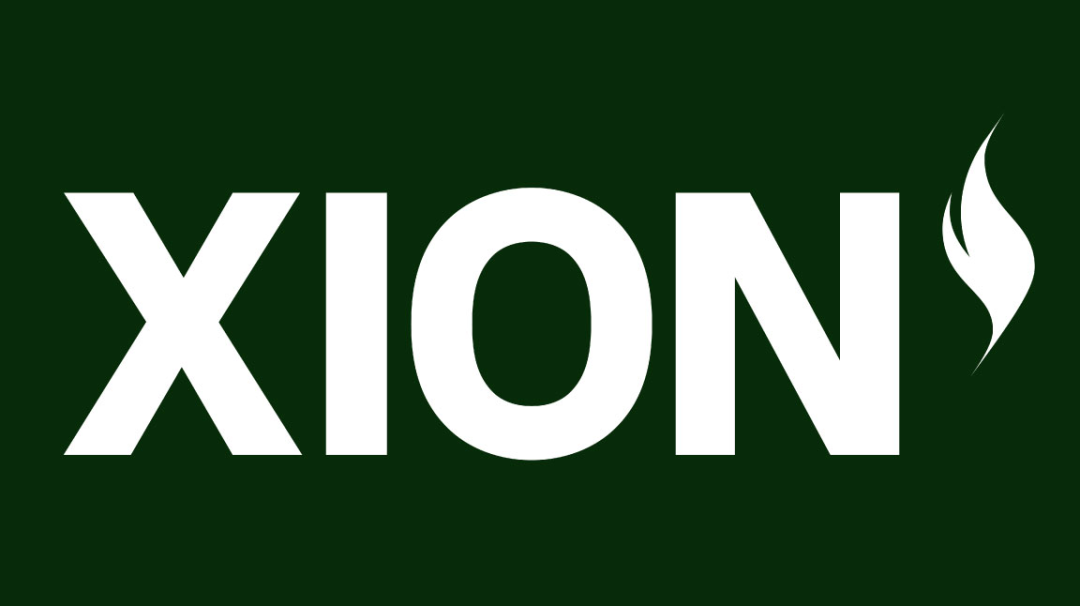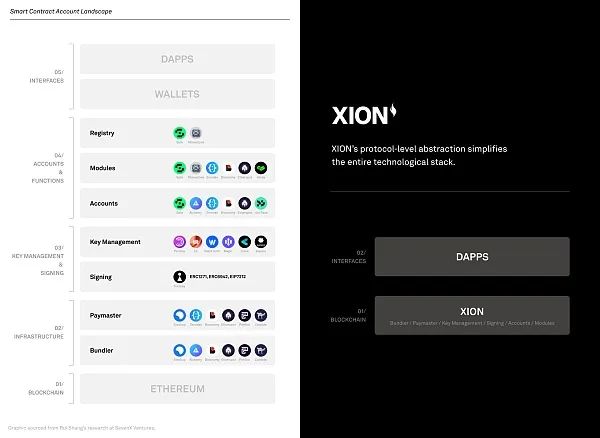
Note: The original article is from XION Blog and has been compiled and translated by XION World.
What is Universal Abstraction?
Universal abstraction is a unique and all-encompassing infrastructure solution designed to eliminate the inherent complexity of encryption for all Web3 users. The key innovation of XION is the direct implementation at the protocol level, including seamless abstraction of accounts, signatures, Gas, interoperability, pricing, devices, payments, and more. In other words, XION brings the decentralization and ownership promises of Web3 to a global mainstream audience by fully abstracting public chains.
XION's Protocol-Level Abstraction
The innovation of XION lies in its protocol-level abstraction, which greatly simplifies the entire technology stack and offers many benefits. Compared to other current public chains, XION not only provides an outstanding solution but also lays the foundation for flexibility to adapt to future dApp innovations.
In the following sections, we outline the problems found in other public chain ecosystems, especially in EVM chains, and how XION is designed to address these issues.
First, XION addresses multiple fragmentation issues found in other EVM chains.

The first is stack fragmentation—as shown in the diagram above, the EVM chain's technology stack contains many different layers. For dApps, the EVM chain requires more than 4 layers to provide the same functionality that XION provides at the foundational level.
The second is standard fragmentation—this is a very "ancient" technical dilemma. SevenX Ventures delves into a perfect example in an article, namely the conflict between safe methods and diamond methods (ERC-2535 diamond proxy). Additionally, multiple companies compete at various levels throughout the technology stack, forcing developers and users to choose which platform to use for each function. Through protocol-level standardization, XION eliminates any incompatibility.
The third is user fragmentation—due to the inability of existing externally owned accounts (EOAs) to seamlessly upgrade to smart contract accounts (SCAs), the existing Web3 ecosystem faces fragmentation issues. Similarly, XION's protocol-level solution has eliminated this situation.
Future-proofing Cryptography: XION's protocol-level solution is curve-agnostic, allowing it to seamlessly accommodate many existing cryptographic curves—such as Ethereum's Secp256K1, Solana's Ed25519, the global standard Secp256R1, JWT's RS256, and more. This clearly gives XION a huge advantage over existing public chain solutions in terms of interoperability, market coverage, and long-term adaptability.
Furthermore, XION's infrastructure has significant advantages in terms of upgradability, cost, and security.
Upgradability: The upgradability provided by XION's protocol-level solution enhances the development and upgrade speed of XION. One of the biggest obstacles to upgrading existing infrastructure in other public chains (especially at the consensus layer) is the impact it has on existing dApps. XION's implementation mitigates this issue, and it also allows existing protocols that do not currently use universal abstraction to seamlessly integrate it into their stack and any future upgrades.
Cost: The cost of deploying and transacting on EVM chains is quite significant, often hindering many potential adopters. XION's innovative technology stack and low-cost structure completely eliminate this cost barrier, making it a more user-friendly and cost-effective solution for developers and users. Additionally, its low fees enable developers and users to perform more computationally intensive operations.
Security: XION's solution does not introduce a secondary memory pool (unlike ERC-4337). This alleviates many of the risks typically faced by other public chains related to centralization, MEV capture, fragmentation, and surveillance. When combined with modularity and ease of upgradability, XION provides the aforementioned enhancement in development speed and, in the long run, it offers high security and resilience.
XION's Universal Abstraction: A Comprehensive Solution
In addition to the benefits of protocol-level abstraction mentioned above, XION's universal abstraction is the only comprehensive solution in the encryption industry.
To effectively address adoption issues, it is imperative to abstract users into various aspects of the encryption field. Adding the functionality for users to log in with their email may simplify one step of the user onboarding process, but if users still need to go through 15 additional steps to understand and manage Gas fees, acquire tokens, and grasp the intrinsic value of these tokens, the simplicity of onboarding becomes meaningless. While the encryption industry has made some interesting attempts to address adoption pain points, XION's protocol-level abstraction is more sustainable, flexible, and feasible in the long run.
Next, we will continue to introduce the robustness of XION's universal abstraction through seven different aspects, each addressing specific industry pain points.
Account Abstraction: XION pioneers modular account abstraction at the protocol level.
Traditional wallets lead to a decrease in user onboarding rates of over 95%. Downloading plugins, enduring complex setups, dealing with confusing pop-ups, understanding and securely storing seed phrases, and coping with unpleasant user experiences are the main obstacles for non-technical users. The solution to this problem is account abstraction and smart contract accounts (SCAs). They not only allow users to use familiar login methods (such as email) but also unlock other security-enhancing features, such as account recovery and account permissions. Furthermore, the rest of XION's account abstraction remains invisible. This subtle and impactful design ensures that developers can focus on creating value without needing to give special consideration to these accounts.
Signature Abstraction: Through signature abstraction, XION is the first public chain to support signatures across all cryptographic curves.
This technological breakthrough means that XION can use Apple's FaceID, passwords, JWT, EVM curves, Solana curves, and more to sign transactions. Additionally, when using non-wallet identity verifiers such as JWT, FaceID, NFC, ZK, etc., there is no need for trusted agents or oracles, as the communication is directly targeted at the chain. This not only enhances security but also perfectly aligns with the "trustless" spirit of Web3.
Payment Abstraction: XION allows users to directly use credit and debit cards for on-chain transactions, eliminating the transaction complexity common in other chains.
In traditional public chains, purchasing goods on-chain using fiat currency is a daunting task, often involving over 15 steps and sometimes taking over a week to complete. Users must endure the ordeal of registering with centralized exchanges, undergoing KYC, waiting for fund transfers, creating wallets, cross-chain fund transfers, and exchanging to the correct tokens before making a purchase. In contrast, XION allows users to complete the entire on-chain transaction experience from start to finish using a bank card in less than 60 seconds, providing a truly familiar Web2 experience for users.
Gas Abstraction: XION completely eliminates the concept of Gas fees from the end user's perspective.
Gas fees have been one of the biggest obstacles for new users entering Web3. In addition to introducing unfamiliar terms to new users, the process of obtaining the necessary Gas tokens is a major barrier for users to enter most public chain ecosystems. This is a significant obstacle not only for end users but also for application builders, as they bear the burden of Gas management and purchase. XION eliminates the barriers for users to enter the ecosystem by leveraging its protocol-level abstraction and removing Gas entirely.
Interoperability Abstraction: XION truly interoperates with all ecosystems, allowing users to seamlessly cross-chain and stake any token on XION.
Especially in an industry filled with different public chains and tokens, it is crucial to make XION accessible to all users. Through its interoperability abstraction, XION enables users from any public chain and holders of any token to trade/stake on XION, thereby unifying the liquidity of all public chain ecosystems.
Device Abstraction: XION completely abstracts the concept of browser wallets or applications, allowing users to access their XION accounts in multiple ways—whether through email, FaceID, password, or other methods—providing strong support and efficient operation across various devices for users.
The ability to easily support all devices (especially mobile devices) truly opens the door to mass adoption of Web3. Today, a significant portion of all digital interactions takes place on mobile phones. However, current mobile encryption wallets pose security risks, do not transition well between different devices, require users to insecurely switch devices using mnemonic phrases, and have very poor UI/UX performance within the current in-app browser. XION's infrastructure ensures that users can easily access their accounts using any device. Additionally, it allows users to separate login from assets, creating a secure pathway for users to interact with new dApps without putting their assets at risk. Essentially, it allows users to access the XION ecosystem securely anytime, anywhere.
Pricing Abstraction: XION is the first public chain to use familiar fiat pricing throughout the entire ecosystem.
Given that USDC is native to crypto, users do not have to worry about needing to avoid risks. Additionally, assets priced in fiat currency eliminate price fluctuations, making many previously impossible use cases possible. Finally, it allows all assets on XION to be priced in currencies familiar to everyday users.
Conclusion: Creating a Scalable Future for Web3
By introducing a modular universal abstraction layer at its core, XION has provided a comprehensive solution to the key issues of user adoption. By addressing the inherent complexity of encryption technology at the protocol level, XION has not only simplified the technology stack but strategically positioned itself as the foundational layer for future innovations. Its powerful infrastructure aims to seamlessly interoperate with all current public chains and adapt to future developments in the long term.
XION's universal abstraction paves the way for future consumer application innovations. It is dedicated to abstracting accounts, signatures, payments, Gas, interoperability, devices, and pricing, allowing all users to access Web3. By encapsulating these complex terms under a unified protocol-level abstraction layer, XION significantly pushes the encryption industry closer to mainstream adoption.
About Burnt and XION
Burnt is developing the future of Web3 by introducing XION, the first Layer-1 blockchain built specifically for consumer adoption by abstracting the complexity of encryption technology, built by Burnt. The mission is to ensure that everyone, regardless of their knowledge of encryption technology, should be able to have equal ownership. Burnt has raised over $11 million from top investors such as Animoca, Circle, Multicoin, Spartan, and HashKey.
Website: https://xion.burnt.com/
Twitter: https://twitter.com/burnt_xion
Discord: https://discord.com/invite/burnt
Telegram: https://t.me/xion_announcements
Follow XION World for more information about XION.
免责声明:本文章仅代表作者个人观点,不代表本平台的立场和观点。本文章仅供信息分享,不构成对任何人的任何投资建议。用户与作者之间的任何争议,与本平台无关。如网页中刊载的文章或图片涉及侵权,请提供相关的权利证明和身份证明发送邮件到support@aicoin.com,本平台相关工作人员将会进行核查。




